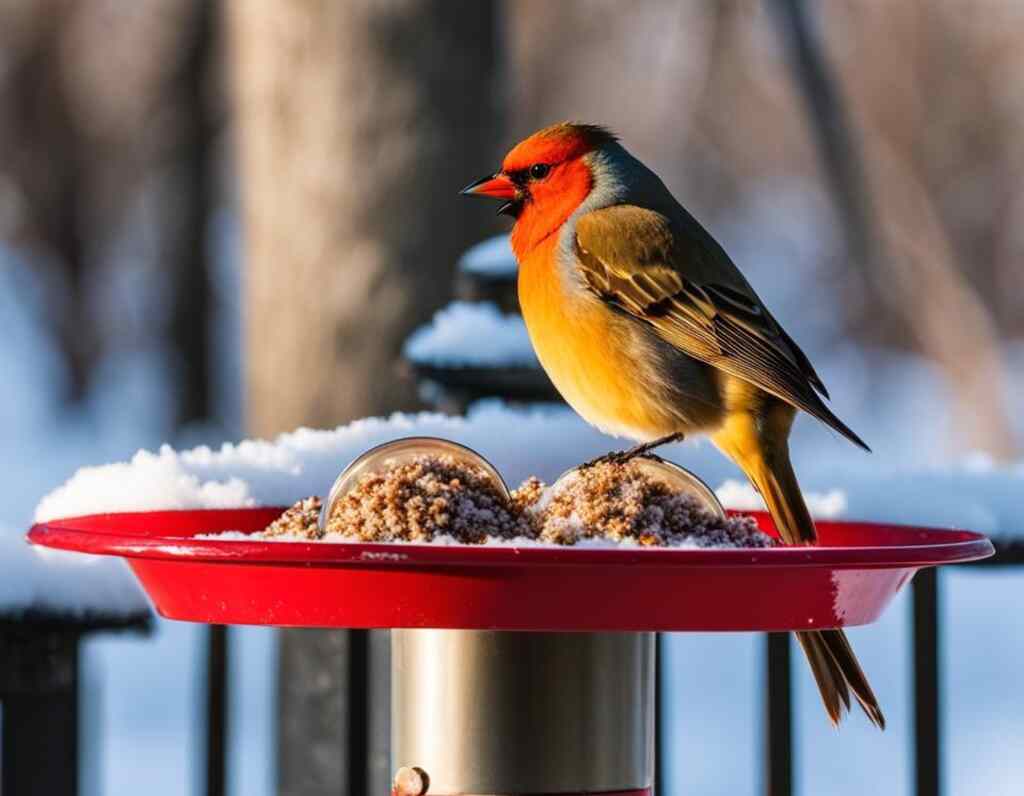Contrary to misconceptions, feeding wild birds is a positive and age-old practice. As humans, we are integral to nature’s tapestry. The tradition of bird feeding spans centuries, with documented instances dating back to the 6th century.
Join us as we debunk bird feeding myths and facts surrounding the art of bird feeding, celebrating our enduring connection with the avian world.”
Table of Contents
- 1 Key Takeaways:
- 2 Myths about Feeding Bread to Ducks
- 3 Debunking the Myth of Birds’ Feet Freezing to Metal Feeders
- 4 Dispelling the Myth of Peanut Butter Choking Birds
- 5 Busting the Myth of Uncooked Rice Swelling in Birds’ Bellies
- 6 Myth-Busting Bird Feeding Disease Transmission
- 7 The Truth about Bird Feeding and Attracting Birds in Winter
- 8 Tips for Safe and Responsible Bird Feeding
- 9 Conclusion
- 10 Source Links
- 11 Author
Key Takeaways:
- The biggest bird feeding myths, debunked
- Bird feeding does not make birds dependent on humans or prevent migration
- Feeding wild birds is a practice that has been in existence for centuries
- Birds rely on a variety of food sources in the wild, even if they visit feeders
- Feeding birds can be a way to connect with nature and support their well-being
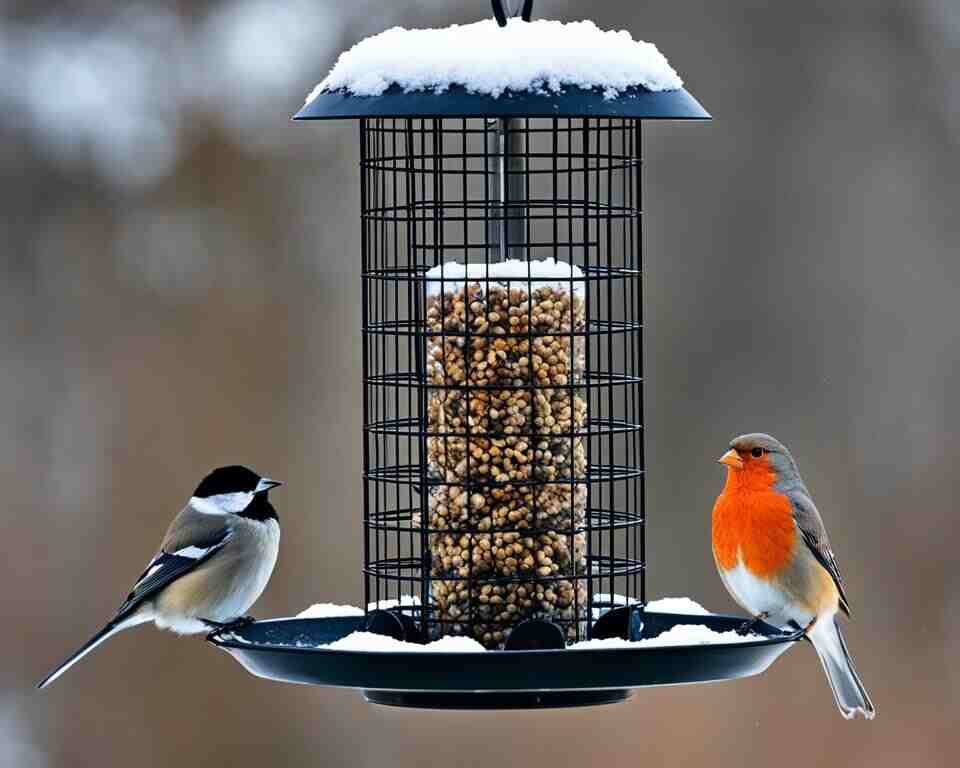
Myths about Feeding Bread to Ducks
Feeding bread to ducks is a popular activity that many people enjoy. However, there are misconceptions regarding its impact on the health of ducks. Let’s separate fact from fiction and explore the truth about feeding bread to ducks.
Myth 1: Feeding bread to ducks is harmful.
Contrary to popular belief, feeding bread to ducks is not inherently harmful. However, it should be done in moderation. Bread has low nutritional value and lacks important nutrients that ducks need for optimal health. Feeding ducks excessive amounts of bread can lead to nutritional deficiencies and other health issues.
Fact 1: Balanced diet for ducks.
Ducks have a varied diet in the wild, consisting of aquatic plants, insects, small fish, and crustaceans. While they may enjoy eating bread, it should be supplemented with other food sources to provide a balanced diet. Grain-based feeds, oats, vegetables, and fruits can be healthier alternatives to bread.
Myth 2: Ducks become dependent on humans for food.
Another misconception is that feeding ducks bread can make them reliant on humans for food. Ducks have innate foraging abilities and will seek out natural food sources even if they are regularly fed by humans. Feeding bread in moderation and offering a variety of foods can actually encourage ducks to maintain their natural foraging behaviors.
Fact 2: Consider the health of the ducks.
When feeding ducks, it is crucial to consider their overall health. Providing a diet that replicates their natural food sources ensures they receive the necessary nutrients to thrive. Including grains, vegetables, and fruits alongside bread can help maintain their well-being.
Fact 3: Environmental impact of bread.
Feeding bread to ducks can have environmental consequences. Excessive bread consumption can lead to water pollution, as bread that is not consumed quickly can sink and ferment, releasing harmful bacteria. To minimize the impact, it is essential to feed ducks in small quantities and ensure that all food is consumed.
Remember, while feeding bread to ducks may be a fun experience, it is important to prioritize their well-being by providing a balanced diet. Let’s create a healthier and more sustainable environment for these beautiful creatures.
Debunking the Myth of Birds’ Feet Freezing to Metal Feeders
One common misconception in bird feeding is the mistaken belief that birds’ feet freeze to metal feeders during winter. However, this is nothing more than a myth that needs to be debunked. Birds’ feet are well adapted to withstand cold temperatures, and they do not produce moisture that would cause them to freeze to metal surfaces.
While it’s important to note that birds may find it difficult to hold onto icy perches, especially during freezing conditions, there are simple steps you can take to alleviate this concern. Moving the feeders to sheltered areas can protect them from the direct impact of harsh weather. Alternatively, you can bring the feeders indoors at night and place them back outside during the day to prevent any freezing issues.
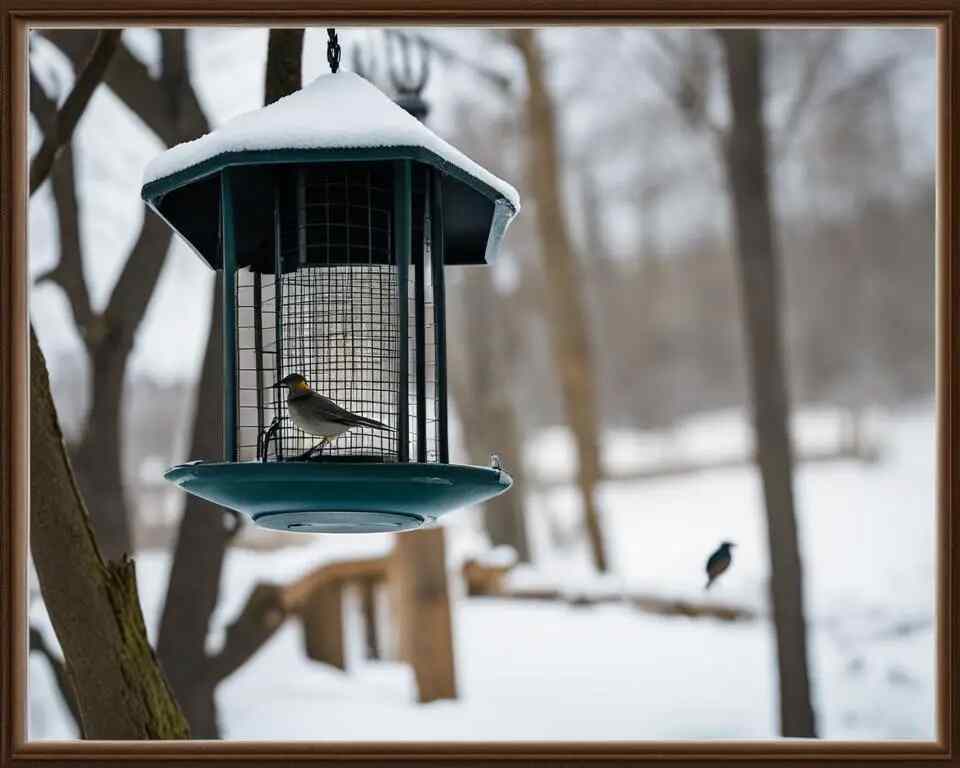
By understanding the truth behind this myth, we can ensure that our bird feeding practices are based on accurate information. This knowledge allows us to provide a safe and comfortable environment for the birds that visit our feeders.
Dispelling the Myth of Peanut Butter Choking Birds
Contrary to popular belief, birds can safely consume peanut butter without the risk of choking. There is no recorded instance of a bird choking on this beloved spread. In fact, peanut butter serves as a nutritious snack for birds, providing them with essential calories and healthy fats.
To make peanut butter more easily accessible for birds, it can be mixed with corn flour to create a crumbly texture. This allows birds to comfortably consume the peanut butter without any difficulties. However, it is important to choose natural peanut butter without added salt or sweeteners for bird feeding, as these additives can be harmful to birds’ health.
Feeding birds peanut butter is an excellent way to supplement their diet and attract a variety of bird species to your feeders. Not only does peanut butter offer nutritional value, but it also acts as a convenient source of energy for birds, especially during colder months when food sources are scarce.
So go ahead and provide peanut butter as a delicious treat for your feathered friends, knowing that you are not putting them at risk of choking. They will appreciate this tasty and nutritious snack.
Here is an example of a simple recipe that mixes peanut butter with corn flour:
- 1 cup of natural peanut butter
- 1 cup of corn flour
Mix the peanut butter and corn flour together until well combined. The resulting mixture will be crumbly and easy for birds to consume. Place small portions of the mixture on bird feeders or offer it on a flat surface, and watch as the birds flock to enjoy this bird-friendly delicacy.
Comparison of Common Bird Feeding Mistakes:
| Mistake | Consequence |
|---|---|
| Feeding birds overly processed peanut butter | Potential harm caused by added salt and sweeteners |
| Mixing peanut butter with unhealthy additives | Reduced nutritional value and potential harm to birds’ health |
| Providing insufficient peanut butter for birds | Inadequate source of energy for birds |
By avoiding these common mistakes and following best practices when feeding peanut butter to birds, you can provide them with a delicious and nutritious treat without any negative consequences.
Busting the Myth of Uncooked Rice Swelling in Birds’ Bellies
When it comes to bird feeding, separating fact from fiction is essential. One common myth that needs debunking is the belief that uncooked rice swells in birds’ bellies, causing harm or even death. The truth is, birds can safely consume uncooked rice without any adverse effects.
Many bird species naturally include rice in their diet. Rice grains provide a good source of carbohydrates and energy, making them a valuable food option for birds. In fact, offering cooked rice as a supplemental snack can be a great way to attract a variety of bird species to your feeders.
However, while uncooked rice itself is safe for birds, it is important to be mindful of other foodstuffs that can be harmful to them. Avoid offering toxic foods such as apple seeds, avocados, tomato leaves, mushrooms, dried beans, onions, salt, chocolate, alcohol, and coffee. These substances can have negative effects on birds’ health and should be kept far away from their feeding areas.
Best Foods to Offer Birds
When it comes to bird feeding, providing a diverse and nutritious diet is key. Here are some great options to include in your bird feeders:
- High-quality birdseed mixes
- Sunflower seeds
- Suet cakes
- Nuts and nut butter (excluding salty or sweetened varieties)
- Dried fruits
- Oats
- Cornmeal
- Cracked corn
Bird-Safe and Toxic Foodstuffs
| Bird-Safe Foods | Toxic Foods to Avoid |
|---|---|
| Rice | Apple seeds |
| Birdseed mixes | Avocados |
| Sunflower seeds | Tomato leaves |
| Suet cakes | Mushrooms |
| Nuts and nut butter | Dried beans |
| Dried fruits | Onions |
| Oats | Salt |
| Cornmeal | Chocolate |
| Cracked corn | Alcohol |
| Coffee |
By separating fact from fiction and providing birds with a safe and nutritious diet, you can enjoy the beauty of these feathered visitors while ensuring their well-being. Remember to clean your bird feeders regularly, offer fresh water, and create a welcoming environment for a wide variety of bird species.
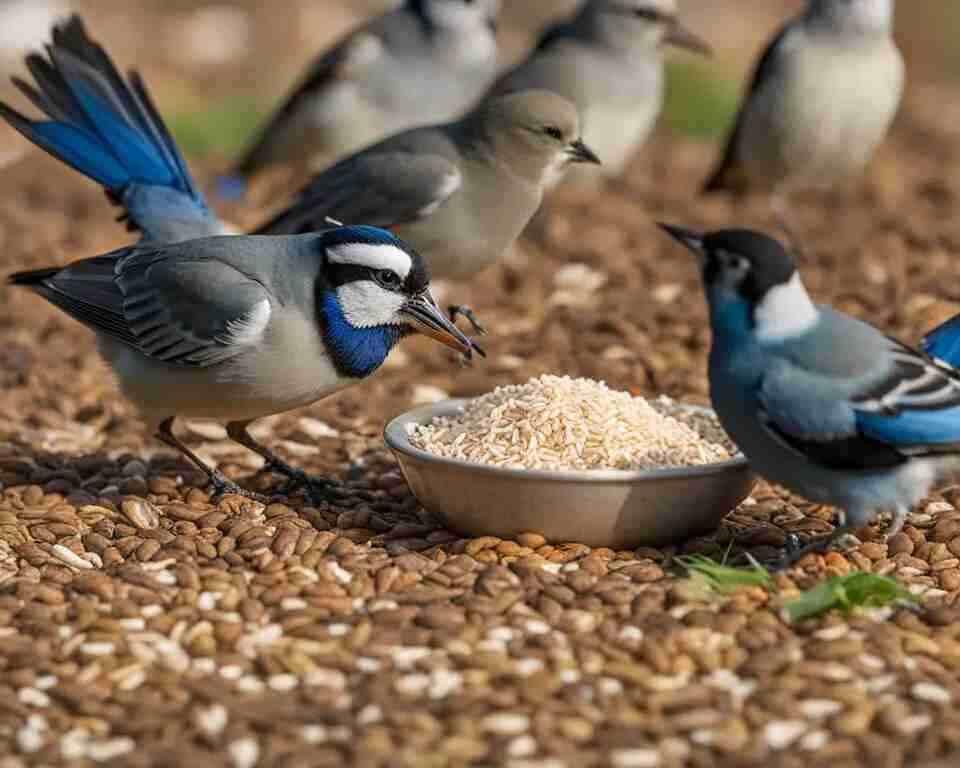
Myth-Busting Bird Feeding Disease Transmission
When it comes to feeding birds, there are plenty of myths and misconceptions that can cause confusion. One common myth is that bird feeders can spread diseases among birds, leading some people to believe that feeding birds can be harmful. However, with proper care and maintenance, the risks can be minimized, and the benefits of bird feeding can far outweigh any potential concerns.
To debunk this myth, let’s explore the best practices for bird feeding and how to prevent disease transmission. Regular cleaning of bird feeders is key to maintaining a healthy feeding environment. It is recommended to clean feeders at least once a month, removing any spilled food and droppings that may accumulate. This helps prevent the spread of bacteria and parasites that could harm the birds.
Best Practices for Bird Feeding to Prevent Disease Transmission
- Regularly clean bird feeders at least once a month to remove bacteria and parasites.
- Remove any spilled food and droppings to prevent the spread of diseases.
- Provide fresh water in clean bird baths or shallow dishes.
- Avoid feeding birds toxic foodstuffs and opt for bird seed mixes and appropriate foods.
- Be cautious when feeding endangered or threatened species to avoid causing any harm.
By following these best practices, you can enjoy the benefits of bird feeding while minimizing the risk of disease transmission. Feeding birds not only provides them with a reliable food source, especially during the winter when natural food may be scarce, but it also allows us to observe and appreciate these beautiful creatures up close.
The Truth about Bird Feeding and Attracting Birds in Winter
During the winter, when natural food sources are scarce, bird feeding becomes especially important. Feeding birds during this time provides them with the necessary energy to survive the cold weather. Contrary to misconceptions, bird feeding does not make them dependent on humans or prevent migration. Instead, it supplements their diet and helps them through the challenging winter months.
In addition to providing food, it is crucial to offer water for birds in winter. Digestion of high-energy food requires hydration, and water can be scarce during freezing temperatures. By ensuring a steady supply of fresh water, you can create an inviting environment for the feathered visitors.
When it comes to bird food, using high-quality bird seed mixes is key. A variety of foods can attract a wider range of bird species to your feeders. It is important to choose seed mixes that are appropriate for the birds in your area and provide the necessary nutrients. By offering a diverse selection of food, you can cater to the preferences and dietary needs of different bird species.
To further dispel misconceptions, let’s debunk some common bird feeding myths:
- Myth: Birds become dependent on feeders during winter. The Truth: Birds continue to rely on a variety of food sources in the wild, and feeding them during winter simply complements their natural diet.
- Myth: Birds will not migrate if they are being fed. The Truth: Migration is a natural instinct for birds and is unaffected by feeding. They will leave when it is time to do so, regardless of the availability of food.
- Myth: Feeding birds in winter can lead to population imbalances. The Truth: Bird feeding in winter does not cause population imbalances. Birds have evolved to adapt to the changing seasons, and their populations are regulated by various factors beyond feeding.
By understanding the truth about bird feeding in winter and dispelling these misconceptions, you can attract and support a diverse range of bird species in your yard or garden. Providing them with nutritious food and fresh water helps them thrive during the challenging winter months.
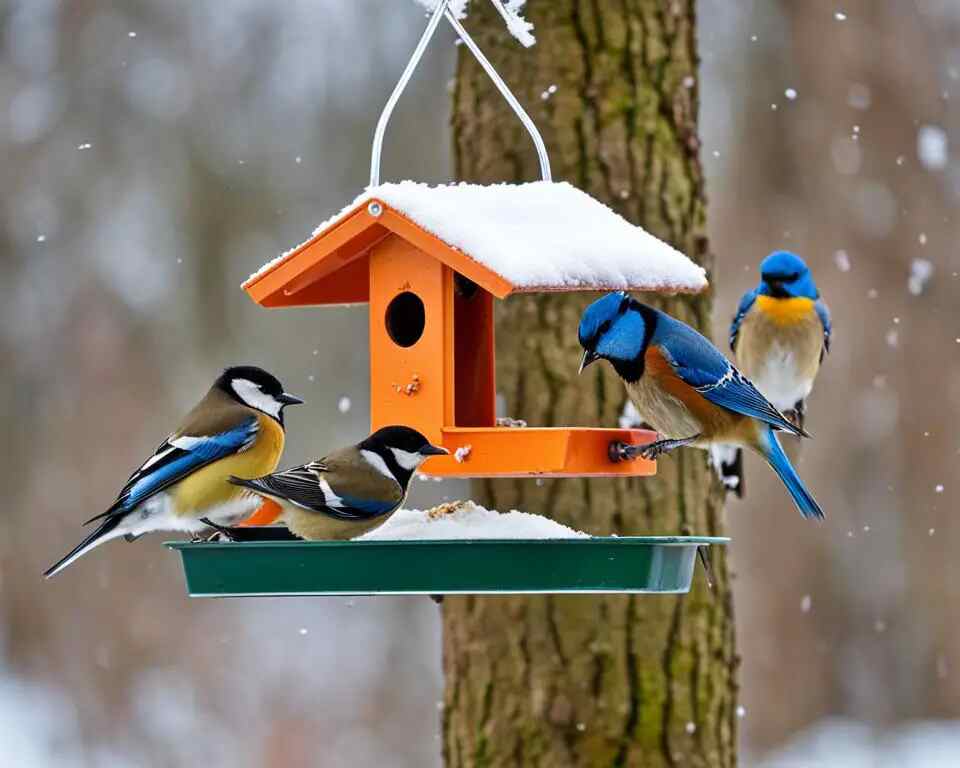
Tips for Safe and Responsible Bird Feeding
To ensure the best bird feeding practices and promote the well-being of our feathered friends, it is crucial to follow safe and responsible techniques. By adhering to these guidelines, we can debunk common myths and separate bird feeding facts from fiction.
Keep Feeders Clean
Regularly cleaning bird feeders is essential to maintain a hygienic feeding environment. Accumulated droppings and moldy food can lead to the spread of diseases, harming the birds we aim to help. Clean feeders at least once a month using a mild detergent and hot water. Rinse thoroughly and allow them to dry completely before refilling with fresh food.
Monitor Food Consumption
Pay attention to how much food is being consumed by the birds visiting your feeders. If the feeders are not being emptied within a day, it may indicate an excessive amount of food being provided. Overfeeding can result in waste, attracting pests, and potentially sharing diseased food. Adjust the quantity of food accordingly to avoid unnecessary waste and maintain a healthy feeding atmosphere.
Provide Fresh Water
Offering fresh water alongside bird feeders is crucial, especially during dry spells or colder months when natural water sources may be scarce. Birds need hydration to aid in the digestion of high-energy foods they consume. Ensure that the water is regularly replenished and clean to avoid the risk of contamination and disease transmission.
Avoid Toxic Foodstuffs
It’s essential to be aware of which foods are safe and appropriate for birds and which can be harmful or even fatal. Several common human foods, such as apple seeds, avocados, chocolate, and alcohol, can be toxic to birds.
To ensure the well-being of our feathered friends, avoid feeding them potentially harmful substances. Stick to birdseed mixes, grains, fruits, nuts, and vegetables that are known to be safe and beneficial for birds.
In sum, following these best bird feeding practices can enhance the experience for both birds and bird enthusiasts. By adopting safe and responsible feeding habits, we can enjoy the wonders of birdwatching while minimizing the risk of disease transmission and harm to our avian friends.
Conclusion
Bird feeding is a popular and enjoyable activity that can benefit both humans and birds. By debunking popular bird feeding myths and correcting misconceptions, we can ensure that our actions are based on facts and promote the well-being of birds.
One of the key mistakes to avoid is the misconception that bird feeding makes birds dependent on humans or prevents migration. Studies have shown that while birds may visit bird feeders, they still rely on a variety of food sources in the wild. Feeding birds instead provides them with an additional food source and can help supplement their diet.
To truly support the health of birds, it is important to provide a balanced diet. This means offering a variety of foods, including seeds, grains, fruits, and vegetables. Additionally, it is crucial to keep feeders clean to prevent the transmission of diseases. Regular cleaning and removal of accumulated droppings can significantly minimize the risk to birds.
By following best practices for bird feeding, such as offering a balanced diet and maintaining clean feeders, we can create a safe and welcoming environment for birds in our yards and gardens. So let’s debunk the myths, correct misconceptions, and enjoy the beauty of birds while ensuring their well-being.

